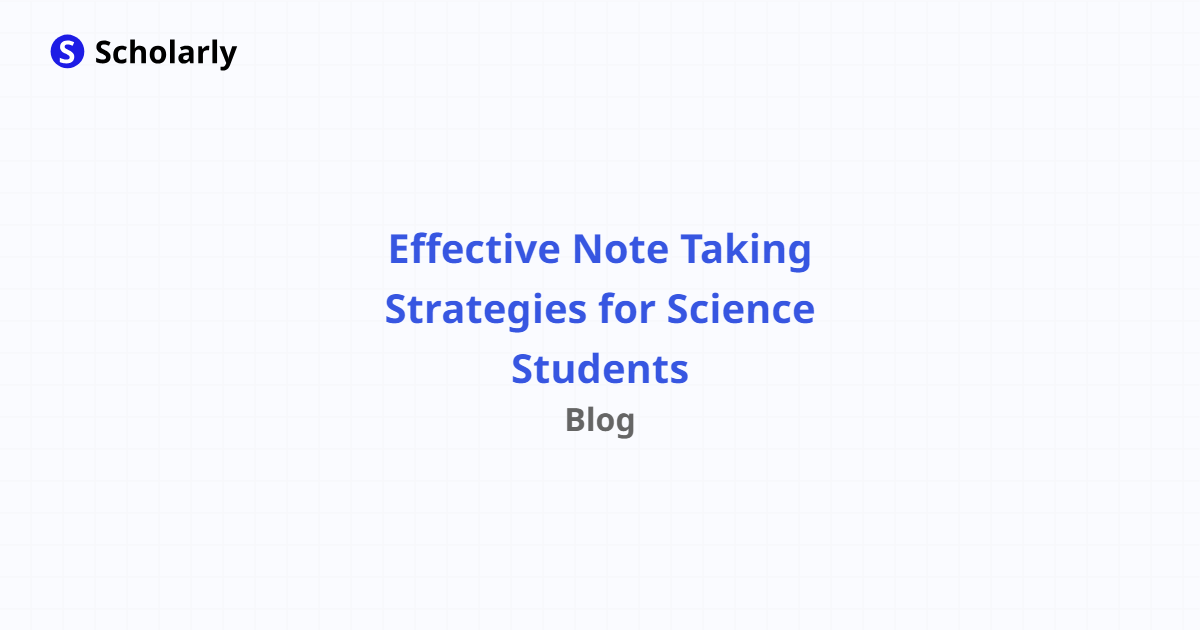Effective Note Taking Strategies for Science Students
Discover how science students can improve their note-taking skills and enhance their learning experience. Explore effective strategies and techniques for capturing and organizing scientific information.

Introduction
Taking effective notes is a crucial skill for students, especially in the field of science. Proper note-taking can help science students comprehend complex concepts, retain information, and excel in their coursework. This article will explore various strategies and techniques that science students can use to improve their note-taking skills and optimize their learning experience.
Benefits of Effective Note Taking
- Enhanced Comprehension:
Effective note-taking enables students to actively engage with the material being presented, enhancing their comprehension and understanding of scientific concepts.
- Retention of Information:
By organizing and summarizing information in their own words, science students can effectively consolidate their learning and improve information retention.
- Reference for Future Study:
Well-crafted notes serve as a valuable resource for future revision and study, allowing students to review and reinforce their understanding of key scientific principles.
- Exam Preparation:
High-quality notes provide a comprehensive overview of the course content, making it easier for students to review and prepare for exams.
- Collaboration and Sharing:
Accurate and well-structured notes can facilitate collaboration and sharing of knowledge among science students.
Best Practices for Note Taking
To maximize the benefits of note-taking in science, students should consider the following best practices:
- Prepare Before the Lecture:
Before attending a lecture or class, it is essential to review any assigned readings or materials. This will provide a foundation of knowledge and help students actively engage with the lecture content.
- Use an Organized Note-Taking System:
Choose a note-taking system that works best for you, such as the Cornell method or the outline method. This will help you structure your notes in a logical and organized manner.
- Listen Actively and Selectively:
During the lecture, listen actively and focus on capturing key points, main ideas, and supporting examples. Avoid transcribing the lecture word for word, as this can hinder understanding and retention.
- Use Visual Aids:
Incorporate visual aids, such as diagrams, graphs, and illustrations, into your notes. Visual representations can help clarify complex scientific concepts and improve understanding.
- Review and Consolidate:
Regularly review your notes, summarize key points, and consolidate information from different sources. This will reinforce your understanding and make it easier to study for exams.
Pros and Cons of Different Note-Taking Methods
Different note-taking methods have their own advantages and disadvantages. Here are some popular note-taking methods for science students:
- Cornell Method:
Pros:
- Provides a clear structure for note-taking
- Emphasizes key points and key details
- Facilitates active learning
Cons:
- Requires more time to review and summarize notes
- May not be suitable for lectures with fast-paced content
- Outline Method:
Pros:
- Organizes information hierarchically
- Allows for easy identification of main ideas and supporting details
- Promotes logical and structured note-taking
Cons:
- May not capture all the nuances and complexity of scientific concepts
- Can be challenging for students who struggle with organization
- Mind Mapping:
Pros:
- Encourages visual thinking
- Facilitates connections between different concepts
- Stimulates creativity and brainstorming
Cons:
- May not provide enough detail for comprehensive study
- Can be time-consuming during note-taking
- Charting Method:
Pros:
- Organizes information in a tabular format
- Enables quick comparison and synthesis of data
- Suitable for organizing experimental results and data
Cons:
- May not be ideal for capturing qualitative or descriptive information
- Can be less effective for courses with a heavy emphasis on theoretical concepts
- Digital Note-Taking:
Pros:
- Offers flexibility and portability
- Allows for easy organization and searchability
- Enables integration of multimedia elements
Cons:
- May be distracting due to internet connectivity
- Requires proficiency in using digital note-taking tools
Comparison of Note-Taking Tools
There are various note-taking tools available to science students. Here's a comparison of some popular tools:
- Evernote:
Evernote is a versatile digital note-taking tool. It allows users to create and organize notes, add images and attachments, and sync across devices. It also offers powerful search features and integrations with other apps.
- OneNote:
OneNote is another popular digital note-taking tool, developed by Microsoft. It offers features similar to Evernote and allows users to create notebooks, sections, and pages. OneNote is particularly well-integrated with Microsoft Office applications.
- Google Keep:
Google Keep is a simple and intuitive note-taking app. It offers basic note-taking features, including text, lists, images, and reminders. Google Keep is fully integrated with other Google apps and can be accessed on both mobile and desktop devices.
- Notion:
Notion is a comprehensive productivity and note-taking app. It allows users to create notes, databases, and projects. Notion offers advanced organization features, including tables, kanban boards, and calendars.
- Pen and Paper:
Traditional pen and paper note-taking remains a popular choice for many science students. Writing by hand can improve memory retention and comprehension. However, paper notes may be less accessible and searchable compared to their digital counterparts.
Conclusion
Effective note-taking is a valuable skill for science students, aiding in comprehension, retention, and exam preparation. By adopting best practices, utilizing suitable note-taking methods, and leveraging digital tools, students can optimize their learning experience and achieve academic success in science. Remember, the key is to actively engage with the material, capture essential information, and periodically review and consolidate your notes. Happy note-taking!
Try Our Popular AI Study Tools
Transform your study materials into interactive learning experiences with our most popular AI-powered tools:
PDF to Flashcards
Convert lecture notes and textbooks into study flashcards instantly
Text to Flashcards
Turn any text or notes into comprehensive flashcard sets
Image to Flashcards
Convert diagrams and handwritten notes into digital flashcards
YouTube to Flashcards
Generate flashcards from educational video content



